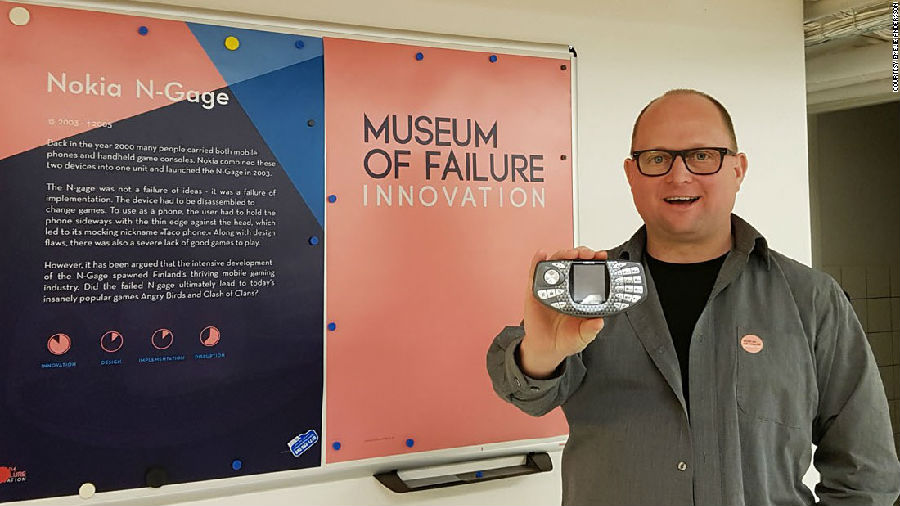一個“失敗”的博物館,有什么好看的?
Everyone fails from time to time. We try to learn from our mistakes and move on, leaving them behind. But one museum is doing quite the opposite. It's a showcase for failures, both famous and forgotten.
每個人都會不時遭遇失敗。我們會吸取教訓,放下失敗,繼續前行。但有座博物館卻恰恰相反 —— 它展示了那些被世人熟知和遺忘的失敗經歷。
Inspired by the Museum of Broken Relationships in Croatia, Samuel West, a psychologist from Sweden, decided to make our silly mistakes public. He founded the Museum of Failure in 2017. Now the museum is hitting the road, with a traveling exhibition in Shanghai from Jan 18 to March 17. The Museum will display over 100 "failed" products from big-name companies such as Nokia, Apple and Coca-Cola.
來自瑞典的心理學家塞繆爾·韋斯特受到位于克羅地亞的“失戀博物館”啟發,決定公開展出人們所犯的愚蠢錯誤。他于2017年創立了“失敗博物館”。如今該博物館展開了巡展,并于1月18日-3月17日期間在上海展出。博物館展出了100多件大牌公司的“失敗”之作,如諾基亞、蘋果和可口可樂等。
"I really hope you see that these mega-brands that everybody respects, they screw up too," West told The New York Times. "I hope that makes you feel less apprehensive about learning something new."
“我真的很希望大家能看到,這些備受人們仰慕的大品牌,也會把事情弄得一團糟,”韋斯特在接受《紐約時報》采訪時表示。“我希望這能讓大家在學習新東西時,不會那么惴惴不安。”

West's opinion isn't new. The famed German-American physicist Albert Einstein once said, "A person who never made a mistake never tried anything new." This idea has even been embraced by big companies in the US. Silicon Valley, for example, is the home of some of the world's most innovative tech companies. A common slogan is, "Fail fast, fail often."
韋斯特的觀點早已有之。著名的美籍德裔物理學家阿爾伯特·愛因斯坦曾說,“不曾犯過錯的人,說明他從未嘗試過新的事物。”這一觀點被美國一眾大公司所接納。比如,硅谷集中了一些全球最具創新力的科技公司。在硅谷圈內有句口號:“快速失敗,經常失敗。”
However, there are reasons for this. "The best companies are those that encourage failure, embrace out-of-the-box thinking, and allow employees to make mistakes and see what happens," wrote Simon Casuto of Forbes.
而這么做也有其道理。“最好的公司會鼓勵失敗,接受創造性思維,并允許員工們犯錯,了解犯錯的后果,”來自《福布斯》雜志的西蒙·卡蘇托寫道。
But some people are skeptical of this so-called "culture of failure". They are worried that if failure becomes "a badge of honor", as Wired magazine put it, it may even be seen as "uncool" when someone tries to reduce the risk of failure. This may lead to carelessness and lack of effort.
但一些人也對這所謂的“失敗文化”存疑。他們擔心失敗會成為“一枚榮譽獎章”,正如《連線》雜志所言,人們試圖降低失敗風險的做法甚至會被視為“一點都不酷”。這或許會導致人們粗心大意,不思進取。
"Sometimes people hide behind failure, when they could have prevented it," wrote Anna Isaac of The Telegraph.
“有時候就算能夠避免失敗,人們也會將失敗作為托詞,”《每日電訊報》的安娜·艾薩克寫道。
So it's important that you set apart the two kinds of failure – the kind that shows laziness or incompetence, and the kind that takes you forward. The key is whether you've learned something from your mistakes.
因此,能夠區分兩種失敗對于人們而言至關重要 —— 一種體現了懶惰與不足,另一種則激勵你前進。而關鍵之處就在于,你是否從失敗中有所收獲。












